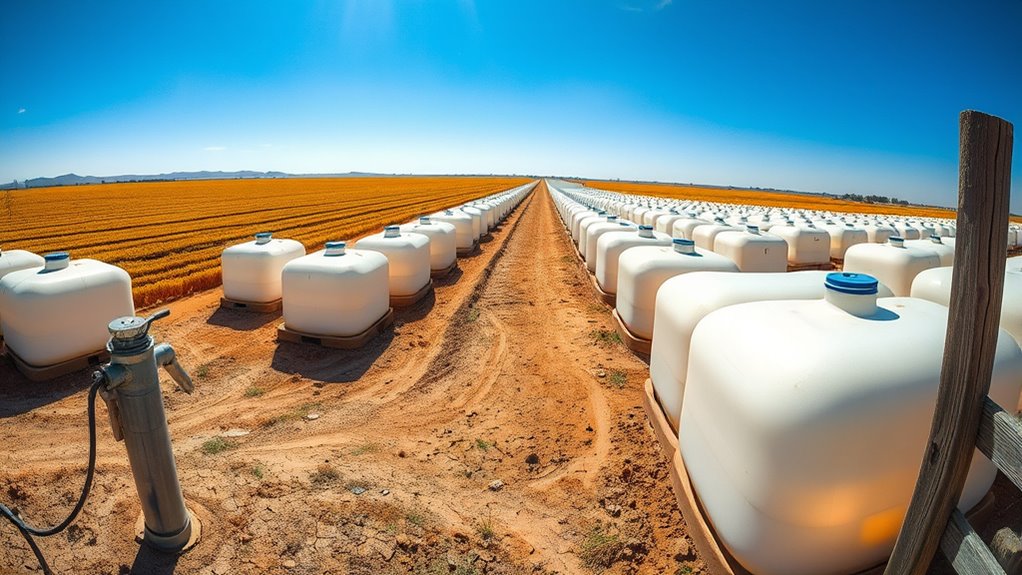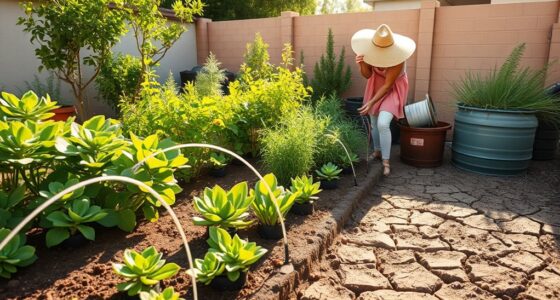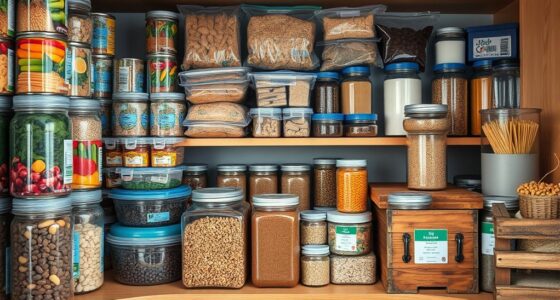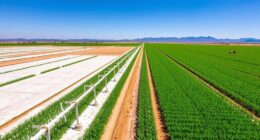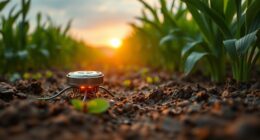To stockpile water reserves on a drought-prone farm, first identify your water needs and reliable sources like wells or rainwater. Choose appropriate storage options such as tanks or underground reservoirs, guaranteeing they’re durable and accessible. Implement rainwater harvesting and conserve water through efficient irrigation and mulch. Regularly monitor usage and maintain your storage systems. Staying aware of legal permits and planning for future shortages ensures long-term water security—if you keep exploring, you’ll uncover more effective strategies.
Key Takeaways
- Assess farm water needs and identify reliable, sustainable sources such as wells, rainwater, or municipal supplies.
- Invest in durable, appropriately-sized storage tanks and reservoirs designed for long-term water security.
- Implement rainwater harvesting systems with gutters, first-flush diverters, and clean, non-toxic storage materials.
- Regularly inspect and maintain water storage facilities to prevent leaks, contamination, and ensure operational readiness.
- Develop contingency plans including alternative sources, water use reduction strategies, and legal compliance measures.
Assessing Water Needs and Supply Sources

Understanding your water needs and supply sources is essential before stockpiling water reserves. You need to determine how much water your farm consumes daily for irrigation, livestock, and other essential activities. Calculate your total water requirements based on crop types, farm size, and seasonal demands. Next, identify reliable water sources such as wells, rivers, rainwater collection, or municipal supplies. Assess the sustainability of each source, considering seasonal variations and potential shortages. Knowing your exact water needs helps you avoid overstocking or understocking, ensuring efficient resource use. Additionally, evaluating the water quality of your sources is crucial to prevent contamination and safeguard your farm’s health. By understanding where your water comes from and how much you need, you’ll be better prepared to develop an effective water storage plan that supports your farm’s resilience during droughts.
Selecting the Right Storage Methods
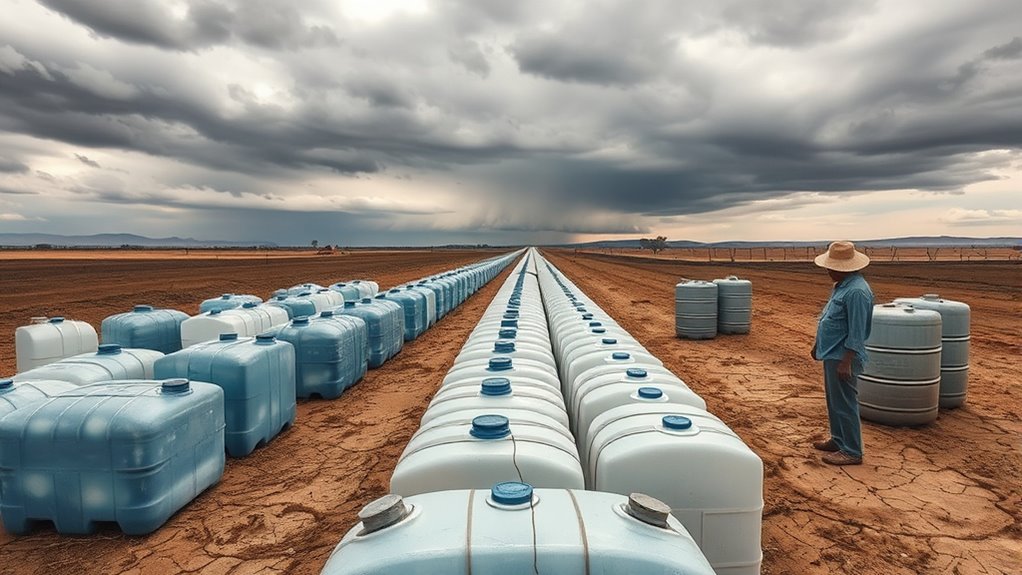
Once you’ve identified your water needs and reliable sources, choosing the right storage methods becomes a key step in ensuring your farm’s water resilience. You need options that suit your farm size, budget, and climate. Consider above-ground tanks for easy access and quick deployment, or underground reservoirs for space-saving and protection from contamination. Material choices like concrete, plastic, or metal influence durability and maintenance. To help you decide, compare these options:
| Storage Method | Key Benefits |
|---|---|
| Above-ground tanks | Easy to install and maintain |
| Underground reservoirs | Space-efficient, protected from elements |
| Flexible containers | Portable, scalable options |
Select methods that balance cost, capacity, and safety, ensuring your water stays secure during droughts. Additionally, evaluating the durability of storage materials is crucial to prevent leaks and contamination over time.
Designing Effective Water Reservoirs

Designing effective water reservoirs requires careful planning to maximize capacity, durability, and safety. You need to take into account site selection, ensuring the location is stable and protected from erosion. Material choice impacts lifespan and maintenance; durable options like concrete or reinforced liners work well. Proper design also involves sizing the reservoir to meet your farm’s water needs without excess. Incorporate features like spillways and overflow outlets to prevent flooding. Additionally, think about ease of access for inspection and maintenance. To help visualize, here are key considerations:
Effective reservoir design ensures durability, safety, and optimal capacity through proper site selection, materials, and overflow features.
- Site stability and protection from erosion
- Material durability and lifespan
- Spillways and overflow management
Implementing the correct water storage methods can significantly enhance your farm’s drought resilience.
Implementing Rainwater Harvesting Systems
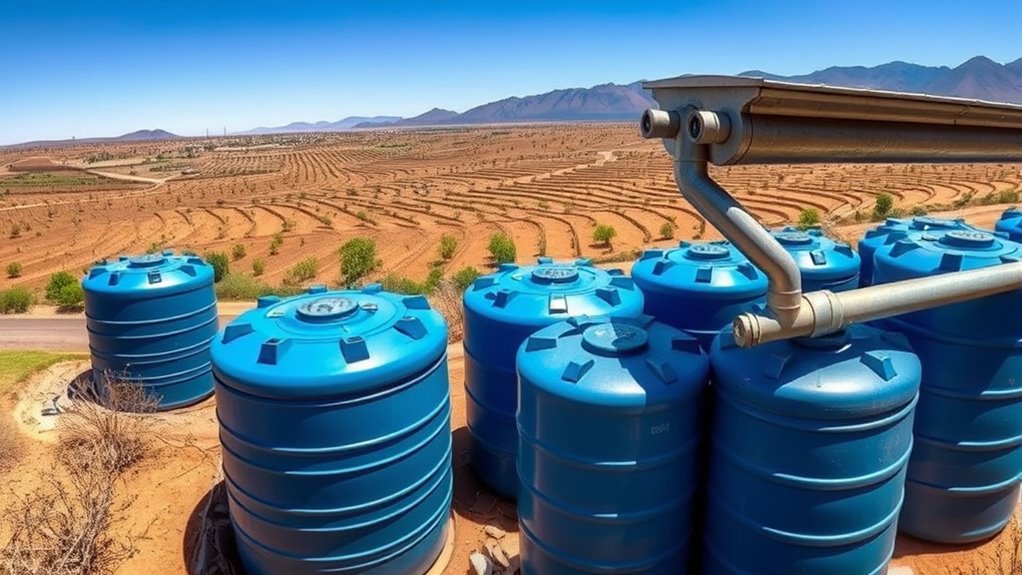
Implementing rainwater harvesting systems can markedly reduce your reliance on external water sources and improve your farm’s water resilience. To start, evaluate your roof surfaces and ensure they’re clean and suitable for collecting rainwater. Install gutters and downspouts to direct water efficiently into storage tanks. Choose tanks made from durable, non-toxic materials, and position them in accessible locations. Incorporate first-flush diverters to prevent debris and contaminants from entering your storage. Regular maintenance is essential—clean filters, inspect for leaks, and ensure proper drainage. Consider integrating simple filtration systems to improve water quality for your crops. Rainwater harvesting is a cost-effective way to supplement your water reserves, especially during dry seasons, and it supports sustainable farming practices. Utilizing low-light office plants in storage or office spaces can also contribute to a healthier environment on your farm.
Utilizing Groundwater and Well Resources
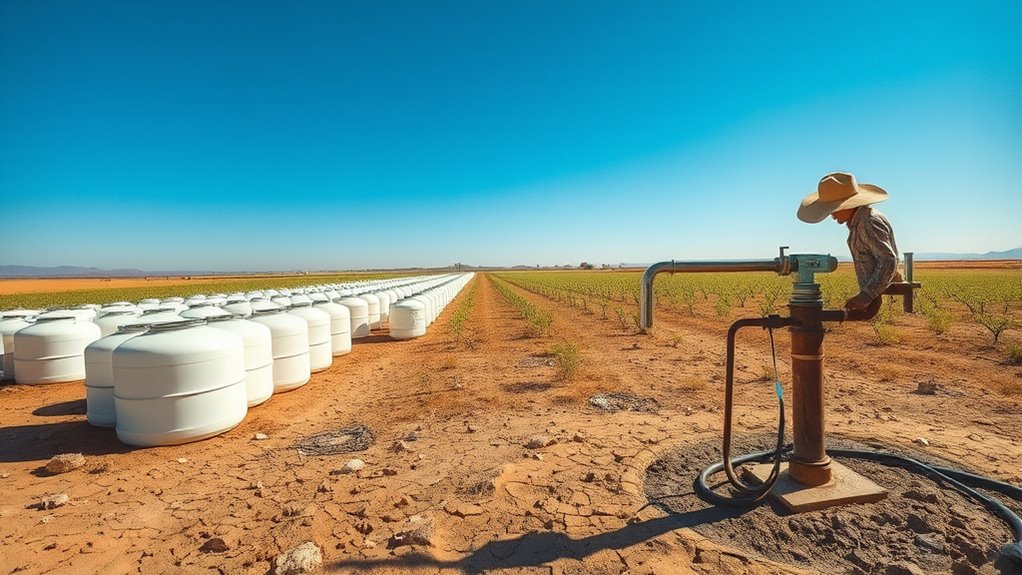
Have you considered how groundwater and well resources can bolster your farm’s water supply? Tapping into these sources offers a reliable, on-demand water source, especially during droughts. To do this effectively, ensure your wells are properly drilled and regularly inspected for safety and efficiency. Installing a pump system suited to your well’s depth maximizes flow and reduces energy costs. Remember, monitoring groundwater levels helps prevent over-extraction and preserves aquifers for future use. Regularly testing water quality to avoid contamination is essential, and incorporating a proper pump system can improve efficiency and longevity. Keep detailed records of water usage and well maintenance.
Managing and Maintaining Water Reserves

To keep your water reserves reliable, you need effective storage techniques and consistent monitoring of water levels. Regular maintenance guarantees your reservoirs stay clean and functional, preventing issues before they arise. By staying proactive, you can confidently manage your water supply for any emergency. Using high-quality water storage containers helps maintain water purity and extends the lifespan of your reserves.
Storage Techniques
Proper storage techniques are essential for maintaining the quality and safety of your water reserves. To keep your water clean and ready for use, choose containers made from food-grade materials and ensure they’re sealed tightly. Position your tanks on level ground away from direct sunlight and chemicals to prevent contamination and algae growth. Regularly inspect your storage for cracks, leaks, or debris, and clean the containers periodically to prevent bacterial buildup. Covering water tanks with secure lids helps keep out pests and dirt. Also, consider installing a simple filtration system to improve water clarity and safety. Additionally, understanding water quality management can help you maintain the integrity of your reserves over time. By paying close attention to these practices, you’ll guarantee your water remains fresh, safe, and ready when you need it most.
Monitoring Water Levels
Monitoring water levels regularly is essential to guarantee your reserves are sufficient and ready for use. You should establish a routine to check water levels consistently, using accurate measuring tools like dipsticks or electronic sensors. Keep detailed records of each measurement to identify trends and potential shortages early. Visual inspections are also helpful; look for signs of contamination, algae growth, or leaks that could compromise water quality or quantity. Regular monitoring helps you detect unexpected drops in water levels caused by evaporation, leaks, or increased usage. This proactive approach ensures you can take timely action if reserves decline unexpectedly. Consistent tracking maintains your awareness of water availability, allowing you to plan withdrawals carefully and avoid running dry during critical periods. Utilizing professional equipment can improve measurement accuracy and reliability.
Maintenance Practices
Effective management and maintenance of your water reserves are essential to guarantee their longevity and safety. Regular upkeep prevents contamination, ensures water quality, and prolongs the lifespan of storage systems. You should routinely inspect tanks and containers for leaks, cracks, or corrosion, addressing issues immediately. Clean and disinfect reservoirs at least once a year to prevent algae, bacteria, and sediment buildup. Keep an eye on valves, filters, and pumps to ensure they function properly, replacing parts as needed. Proper labeling of water sources and maintenance schedules helps you stay organized and prepared. Additionally, understanding the types of headphone jacks and their compatibility can be useful when monitoring audio equipment used during farm management or inspections.
Incorporating Water Conservation Practices

Implementing water conservation practices is essential for maximizing your water reserves and ensuring sustainability during shortages. Start by scheduling irrigation during cooler parts of the day, like early morning or late evening, to reduce evaporation. Use drip irrigation or soaker hoses to deliver water directly to plant roots, minimizing waste. Mulch around crops to retain soil moisture and lower evaporation rates. Fix leaks promptly in your irrigation system to prevent unnecessary water loss. Adjust watering based on weather conditions, avoiding overwatering that wastes resources. Collect rainwater whenever possible to supplement your reserves. Educate yourself on drought-tolerant crops that require less water, and adopt soil management techniques to improve water retention. Water conservation practices help extend your water supply and build resilience for drought periods.
Monitoring and Optimizing Water Usage

To make the most of your water reserves, you need to monitor your usage closely. Implementing water tracking helps you identify areas where you can cut back. By adjusting your habits efficiently, you guarantee your supply lasts longer during emergencies.
Implement Water Tracking
Tracking your water usage is essential for identifying waste and optimizing your reserves. By monitoring how much water you consume daily, you can spot patterns and pinpoint inefficiencies. Implementing a reliable tracking system helps you make informed decisions about water allocation and prevents unnecessary loss. To get started, consider these key steps:
- Use water meters or sensors to measure daily consumption accurately
- Keep a detailed log to compare usage over time
- Set specific goals to reduce waste and track progress regularly
This ongoing process keeps you aware of your water habits and reveals opportunities for saving. Consistent tracking enables you to fine-tune your water management, ensuring your reserves are used wisely and prepared for drought conditions.
Adjust Usage Efficiently
Once you understand your water usage patterns, you can take targeted steps to modify and optimize consumption. Review your data regularly to identify areas where water is wasted or overused. Implement strategies like watering during cooler parts of the day to reduce evaporation, and use drip irrigation instead of sprinklers for efficiency. Adjust irrigation schedules based on crop needs and weather forecasts to avoid unnecessary watering. Consider installing sensors or automating valves to fine-tune water delivery precisely where and when it’s needed. Train yourself and your workers to recognize signs of overwatering or underwatering. By actively monitoring and adjusting your practices, you’ll conserve water, lower costs, and ensure your farm remains resilient during drought conditions.
Legal Considerations and Permits for Water Storage
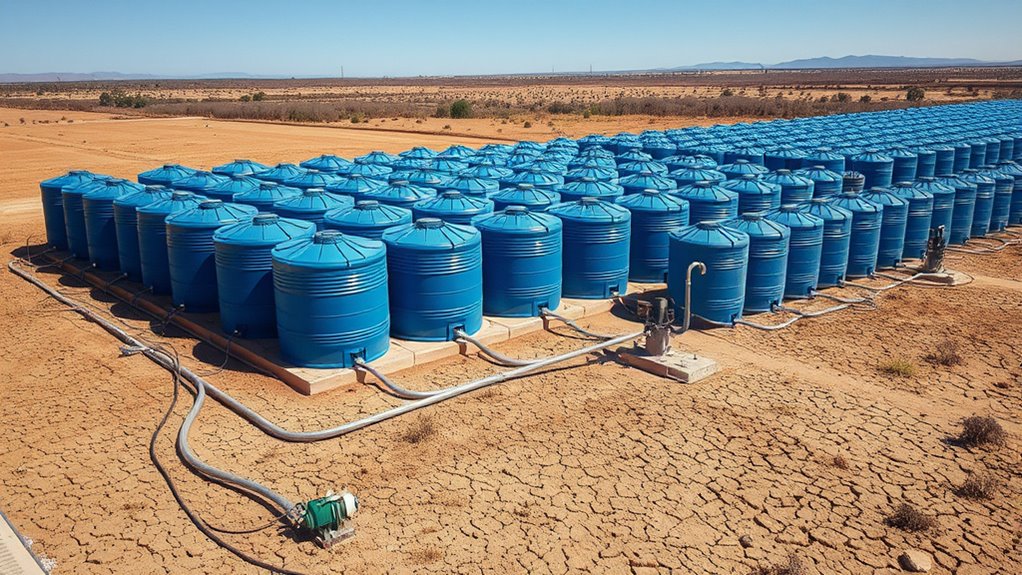
Legal considerations and permits are crucial when stockpiling water, as regulations vary by location and can considerably impact your storage plans. You must understand local laws to avoid fines or project delays. Check if you need permits for large containers or if there are restrictions on water collection methods. Some regions require permits for groundwater extraction or storage, while others might have specific safety standards. Failing to comply can lead to legal issues or water rights conflicts. It’s essential to consult with local authorities or water agencies early in your planning process. Staying informed helps you avoid costly mistakes and ensures your water reserves are compliant and secure.
- Confirm if permits are required for your storage size
- Understand water rights and restrictions in your area
- Follow safety standards for water containers
Planning for Long-term Water Security

To guarantee long-term water security, you need to accurately assess your future water needs and plan accordingly. Invest in reliable storage solutions that can hold enough water for emergencies and sustained use. Additionally, develop contingency plans to address potential disruptions and keep your water supply resilient over time.
Assess Water Needs
Have you ever considered how much water your community will need decades from now? Planning for the future requires understanding your current water consumption and anticipating growth. You should evaluate your farm’s water needs based on crop types, seasonal variations, and livestock requirements.
To do this effectively, consider:
- Analyzing past water usage data to identify trends and peak demands
- Estimating future needs based on planned expansions or new crops
- Factoring in climate change impacts that could alter rainfall and water availability
Invest in Storage
Effective water management starts with ensuring you have reliable storage systems in place. Investing in durable tanks, reservoirs, or underground storage guarantees a steady supply during droughts. Proper storage helps you balance supply and demand, reduce water waste, and safeguard your farm’s productivity. When choosing storage options, consider capacity, location, and maintenance needs to maximize efficiency. Installing multiple storage units can provide redundancy, preventing shortages if one system fails. Additionally, integrating smart monitoring technology allows you to track water levels and quality in real time. Use the table below to compare storage options:
| Storage Type | Capacity | Maintenance Needs |
|---|---|---|
| Above-ground tanks | Small to large | Moderate, periodic checks |
| Underground reservoirs | Large | Low, periodic inspection |
| Cisterns | Varies | Low to moderate |
| Ponds | Large | Seasonal upkeep |
| Modular systems | Flexible sizes | Minimal, scalable |
Develop Contingency Plans
Planning for long-term water security requires you to develop extensive contingency plans that address potential shortages and disruptions. You need clear, actionable steps to ensure your farm remains resilient when water supplies fluctuate. First, identify alternative water sources, like nearby rivers or underground wells, so you’re prepared if your primary supply diminishes. Second, establish communication protocols with suppliers and local authorities to stay informed about drought alerts or restrictions. Third, create a schedule for regular system maintenance and testing to prevent failures during critical times. By proactively planning for various scenarios, you minimize risks and maintain productivity. These steps help you adapt quickly, ensuring your farm stays sustainable even during severe droughts or unexpected disruptions.
Frequently Asked Questions
How Can I Estimate Future Water Needs Accurately for Drought-Prone Farms?
To estimate future water needs accurately, analyze past water usage data during different seasons and drought conditions. Consider crop types, growth stages, and irrigation methods to refine estimates. Use weather forecasts and climate models to project drought patterns. Regularly monitor soil moisture levels and adjust your plans accordingly. Implementing these steps helps you anticipate water demands better, ensuring your farm remains resilient during droughts.
What Are the Cost Implications of Different Water Storage Options?
You might worry about high costs, but investing in water storage options can save money long-term. Above-ground tanks are cheaper upfront but need space and maintenance. Underground reservoirs cost more initially but last longer and reduce evaporation loss. Consider your farm size, water needs, and budget to choose the best option. Properly sized and managed storage can prevent costly crop failures during droughts, making it a smart investment.
How Do Climate Change Trends Affect Water Reserve Planning?
Climate change trends make water reserve planning more urgent and complex. You’ll need to account for increased drought frequency, unpredictable rainfall, and rising temperatures that reduce water availability. To stay resilient, you should invest in larger, more flexible storage systems and diversify water sources. Regularly update your plans based on climate data, and incorporate conservation strategies to guarantee your farm can withstand changing weather patterns.
What Are the Best Practices for Preventing Water Contamination in Reserves?
Think of your water reserve like a clean pond; if you don’t guard against contamination, it turns murky. To prevent this, regularly test water quality, avoid using harmful chemicals nearby, and guarantee proper sealing of storage containers. Implementing a routine inspection schedule and maintaining good hygiene standards keeps your reserves safe. This proactive approach ensures your water stays pure, just like a pristine pond, ready for use when you need it most.
How Can Technology Improve Water Monitoring and Management Efficiency?
Technology can considerably boost your water monitoring and management by providing real-time data through sensors and automation systems. You can quickly detect contamination, monitor water levels, and optimize usage with smart software. Drones and satellite imagery help you oversee large reserves efficiently, while data analytics predict drought patterns. Using these tools, you make informed decisions faster, reduce waste, and guarantee your water reserves stay safe and sustainable for drought-prone farms.
Conclusion
By stockpiling water wisely, you plant the seeds for resilience in your drought-prone farm. Every drop stored is a lifeline waiting to flourish when the rains retreat, a steady heartbeat in your farming rhythm. With careful planning, your water reserves become a shield against drought’s harsh whispers, ensuring your land remains vibrant and productive. Embrace these practices, and watch your water security grow like a mighty oak, rooted deep and reaching for the sky.

